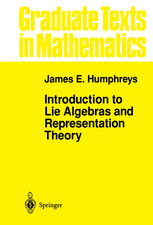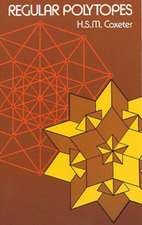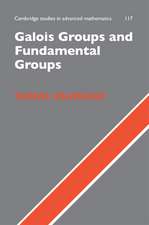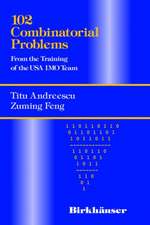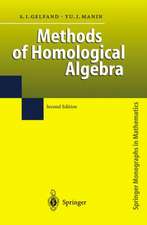Linear Algebra
Autor Jin Ho Kwak, Sungpyo Hongen Limba Engleză Paperback – 15 apr 2004
Key topics and features include:
* Linear equations, matrices, determinants, vector spaces, complex vector spaces, inner products, Jordan canonical forms, and quadratic forms
* Rich selection of examples and explanations, as well as a wide range of exercises at the end of every section
* Selected answers and hints
* Excellent index
This second edition includes substantial revisions, new material on minimal polynomials and diagonalization, as well as a variety of new applications. The text will serve theoretical and applied courses and is ideal for self-study. With its important approach to linear algebra as a coherent part of mathematics and as a vital component of the natural and social sciences, Linear Algebra, Second Edition will challenge and benefit a broad audience.
Preț: 494.70 lei
Nou
Puncte Express: 742
Preț estimativ în valută:
94.66€ • 99.10$ • 78.33£
94.66€ • 99.10$ • 78.33£
Carte tipărită la comandă
Livrare economică 05-19 aprilie
Preluare comenzi: 021 569.72.76
Specificații
ISBN-13: 9780817642945
ISBN-10: 0817642943
Pagini: 390
Ilustrații: XV, 390 p. 9 illus.
Dimensiuni: 155 x 235 x 19 mm
Greutate: 0.58 kg
Ediția:2nd ed. 2004
Editura: Birkhäuser Boston
Colecția Birkhäuser
Locul publicării:Boston, MA, United States
ISBN-10: 0817642943
Pagini: 390
Ilustrații: XV, 390 p. 9 illus.
Dimensiuni: 155 x 235 x 19 mm
Greutate: 0.58 kg
Ediția:2nd ed. 2004
Editura: Birkhäuser Boston
Colecția Birkhäuser
Locul publicării:Boston, MA, United States
Public țintă
Lower undergraduateCuprins
1 Linear Equations and Matrices.- 1.1 Systems of linear equations.- 1.2 Gaussian elimination.- 1.3 Sums and scalar multiplications of matrices.- 1.4 Products of matrices.- 1.5 Block matrices.- 1.6 Inverse matrices.- 1.7 Elementary matrices and finding A?1.- 1.8 LDU factorization.- 1.9 Applications.- 1.10 Exercises.- 2 Determinants.- 2.1 Basic properties of the determinant.- 2.2 Existence and uniqueness of the determinant.- 2.3 Cofactor expansion.- 2.4 Cramer’s rule.- 2.5 Applications.- 2.6 Exercises.- 3 Vector Spaces.- 3.1 The n-space ?n and vector spaces.- 3.2 Subspaces.- 3.3 Bases.- 3.4 Dimensions.- 3.5 Row and column spaces.- 3.6 Rank and nullity.- 3.7 Bases for subspaces.- 3.8 Invertibility.- 3.9 Applications.- 3.10 Exercises>.- 4 Linear Transformations.- 4.1 Basic propertiesof linear transformations.- 4.2 Invertiblelinear transformations.- 4.3 Matrices of linear transformations.- 4.4 Vector spaces of linear transformations.- 4.5 Change of bases.- 4.6 Similarity.- 4.7. Applications.- 4.8 Exercises.- 5 Inner Product Spaces.- 5.1 Dot products and inner products.- 5.2 The lengths and angles of vectors.- 5.3 Matrix representations of inner products.- 5.4 Gram-Schmidt orthogonalization.- 5.5 Projections.- 5.6 Orthogonal projections.- 5.7 Relations of fundamental subspaces.- 5.8 Orthogonal matrices and isometries.- 5.9 Applications.- 5.10 Exercises.- 6 Diagonalization.- 6.1 Eigenvalues and eigenvectors.- 6.2 Diagonalization of matrices.- 6.3 Applications.- 6.4 Exponential matrices.- 6.5 Applications continued.- 6.6 Diagonalization of linear transformations.- 6.7 Exercises.- 7 Complex Vector Spaces.- 7.1 The n-space ?n and complex vector spaces.- 7.2 Hermitian and unitary matrices.- 7.3 Unitarily diagonalizable matrices.- 7.4 Normal matrices.- 7.5 Application.- 7.6Exercises.- 8 Jordan Canonical Forms.- 8.1 Basic properties of Jordan canonical forms.- 8.2 Generalized eigenvectors.- 8.3 The power Ak and the exponential eA.- 8.4 Cayley-Hamilton theorem.- 8.5 The minimal polynomial of a matrix>.- 8.6 Applications.- 8.7 Exercises.- 9 Quadratic Forms.- 9.1 Basic properties of quadratic forms.- 9.2 Diagonalization of quadratic forms.- 9.3 A classification of level surfaces.- 9.4 Characterizations of definite forms.- 9.5 Congruence relation.- 9.6 Bilinear and Hermitian forms.- 9.7 Diagonalization of bilinear or Hermitian forms.- 9.8 Applications.- 9.9 Exercises.- Selected Answers and Hints.
Recenzii
From the reviews:
"This is a standard book on Linear Algebra for science and engineering students. It covers the usual topics, including the Jordan canonical form, a topic that is omitted in many recent books at this level.
The book reminded me of Strang's Linear Algebra and its Applications.... Like Strang, the authors discuss linear difference and differential equations at some length, which should be useful to students in applied sciences. Unlike Strang, however, Kwak and Hong follow a more traditional line of presentation, with numbered definitions, lemmas, theorems, and examples. This may make it easier for the student to use the book as a reference. The exposition is clear but the style is not as chatty as Strang's.
In summary, the book can be safely used as the basis for a course on Linear Algebra for the intended audience." —MAA Reviews
“The emphasis is on computational skills along with mathematical abstractions; basic concepts are introduced by means of matrices and the solution of systems of linear equations. Many illustrative examples are given and all the usual advanced topics are treated … The second edition has been substantially revised and new sections have been added.” (ZENTRALBLATT MATH)
"As linear algebra is one of the most important subjects in the study of science and engineering because of widespread applications in social or natural science, computer science, physics, or economics this book covers one of the most useful courses in undergraduate mathematics, providing essential tooks for industrial scientists. . . The primary purpose of the book is to give a careful presentation of the basic concepts of linear algebra as a coherent part of mathematics, and to illustrate its power and utility through applications of other disciplines.
---Educational Book Review
"This is a standard book on Linear Algebra for science and engineering students. It covers the usual topics, including the Jordan canonical form, a topic that is omitted in many recent books at this level.
The book reminded me of Strang's Linear Algebra and its Applications.... Like Strang, the authors discuss linear difference and differential equations at some length, which should be useful to students in applied sciences. Unlike Strang, however, Kwak and Hong follow a more traditional line of presentation, with numbered definitions, lemmas, theorems, and examples. This may make it easier for the student to use the book as a reference. The exposition is clear but the style is not as chatty as Strang's.
In summary, the book can be safely used as the basis for a course on Linear Algebra for the intended audience." —MAA Reviews
“The emphasis is on computational skills along with mathematical abstractions; basic concepts are introduced by means of matrices and the solution of systems of linear equations. Many illustrative examples are given and all the usual advanced topics are treated … The second edition has been substantially revised and new sections have been added.” (ZENTRALBLATT MATH)
"As linear algebra is one of the most important subjects in the study of science and engineering because of widespread applications in social or natural science, computer science, physics, or economics this book covers one of the most useful courses in undergraduate mathematics, providing essential tooks for industrial scientists. . . The primary purpose of the book is to give a careful presentation of the basic concepts of linear algebra as a coherent part of mathematics, and to illustrate its power and utility through applications of other disciplines.
---Educational Book Review
Textul de pe ultima copertă
"A logical development of the subject…all the important theorems and results are discussed in terms of simple worked examples. The student's understanding…is tested by problems at the end of each subsection, and every chapter ends with exercises."
--- "Current Science" (Review of the First Edition)
A cornerstone of undergraduate mathematics, science, and engineering, this clear and rigorous presentation of the fundamentals of linear algebra is unique in its emphasis and integration of computational skills and mathematical abstractions. The power and utility of this beautiful subject is demonstrated, in particular, in its focus on linear recurrence, difference and differential equations that affect applications in physics, computer science, and economics.
Key topics and features include:
* Linear equations, matrices, determinants, vector spaces, complex vector spaces, inner products, Jordan canonical forms, and quadratic forms
* Rich selection of examples and explanations, as well as a wide range of exercises at the end of every section
* Selected answers and hints
This second edition includes substantial revisions, new material on minimal polynomials and diagonalization, as well as a variety of new applications. The text will serve theoretical and applied courses and is ideal for self-study. With its important approach to linear algebra as a coherent part of mathematics and as a vital component of the natural and social sciences, "Linear Algebra, Second Edition" will challenge and benefit a broad audience.
--- "Current Science" (Review of the First Edition)
A cornerstone of undergraduate mathematics, science, and engineering, this clear and rigorous presentation of the fundamentals of linear algebra is unique in its emphasis and integration of computational skills and mathematical abstractions. The power and utility of this beautiful subject is demonstrated, in particular, in its focus on linear recurrence, difference and differential equations that affect applications in physics, computer science, and economics.
Key topics and features include:
* Linear equations, matrices, determinants, vector spaces, complex vector spaces, inner products, Jordan canonical forms, and quadratic forms
* Rich selection of examples and explanations, as well as a wide range of exercises at the end of every section
* Selected answers and hints
This second edition includes substantial revisions, new material on minimal polynomials and diagonalization, as well as a variety of new applications. The text will serve theoretical and applied courses and is ideal for self-study. With its important approach to linear algebra as a coherent part of mathematics and as a vital component of the natural and social sciences, "Linear Algebra, Second Edition" will challenge and benefit a broad audience.
Caracteristici
Presents the basic concepts of linear algebra as a coherent part of mathematics Differs from competitors in its emphasis and integration of computational skills and mathematical abstractions Variety of applications new to 2nd ed. Motivated by appropriate Examples and Exercises, Selected Answers and Hints, plus a Comprehensive Index





